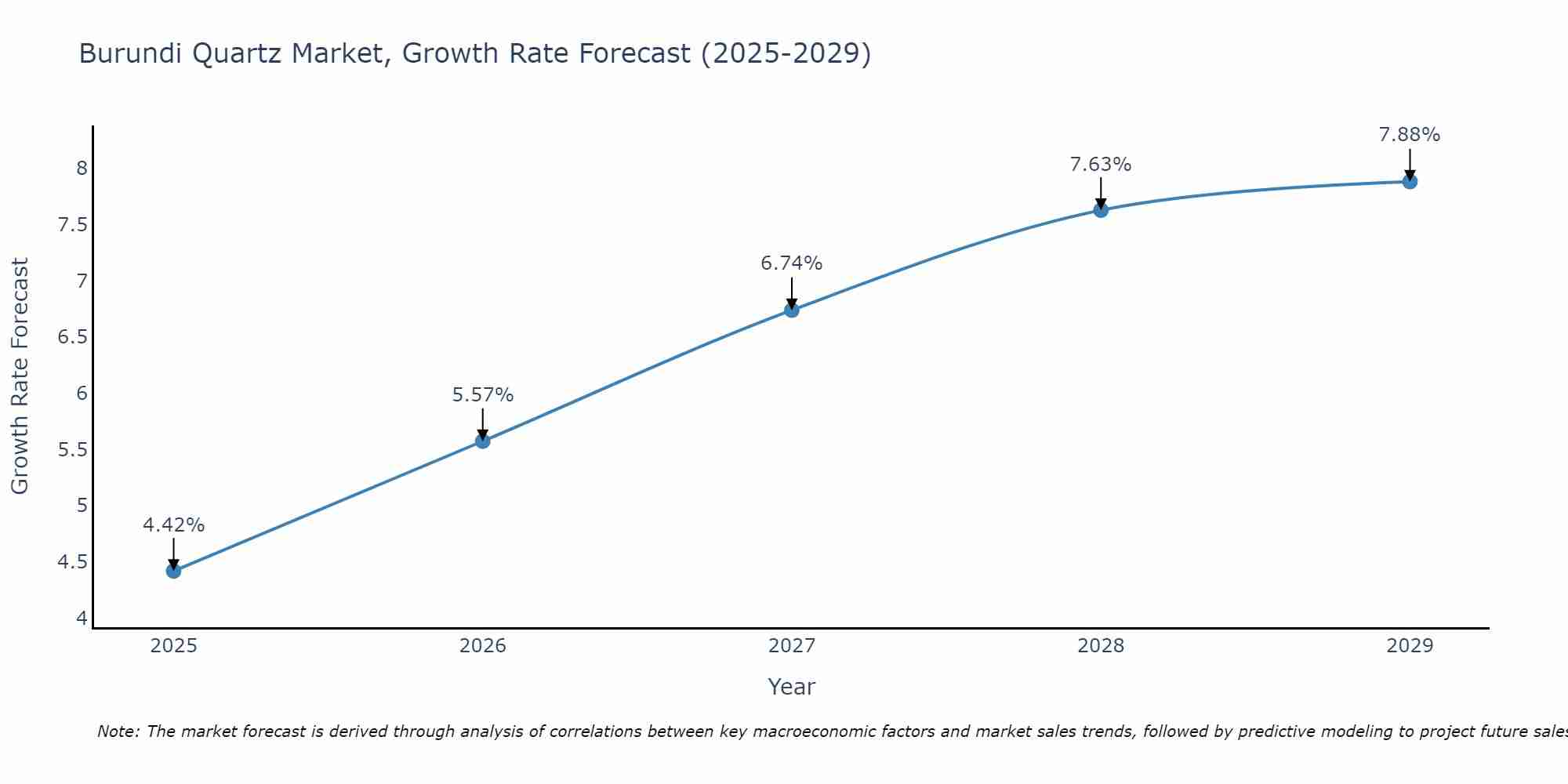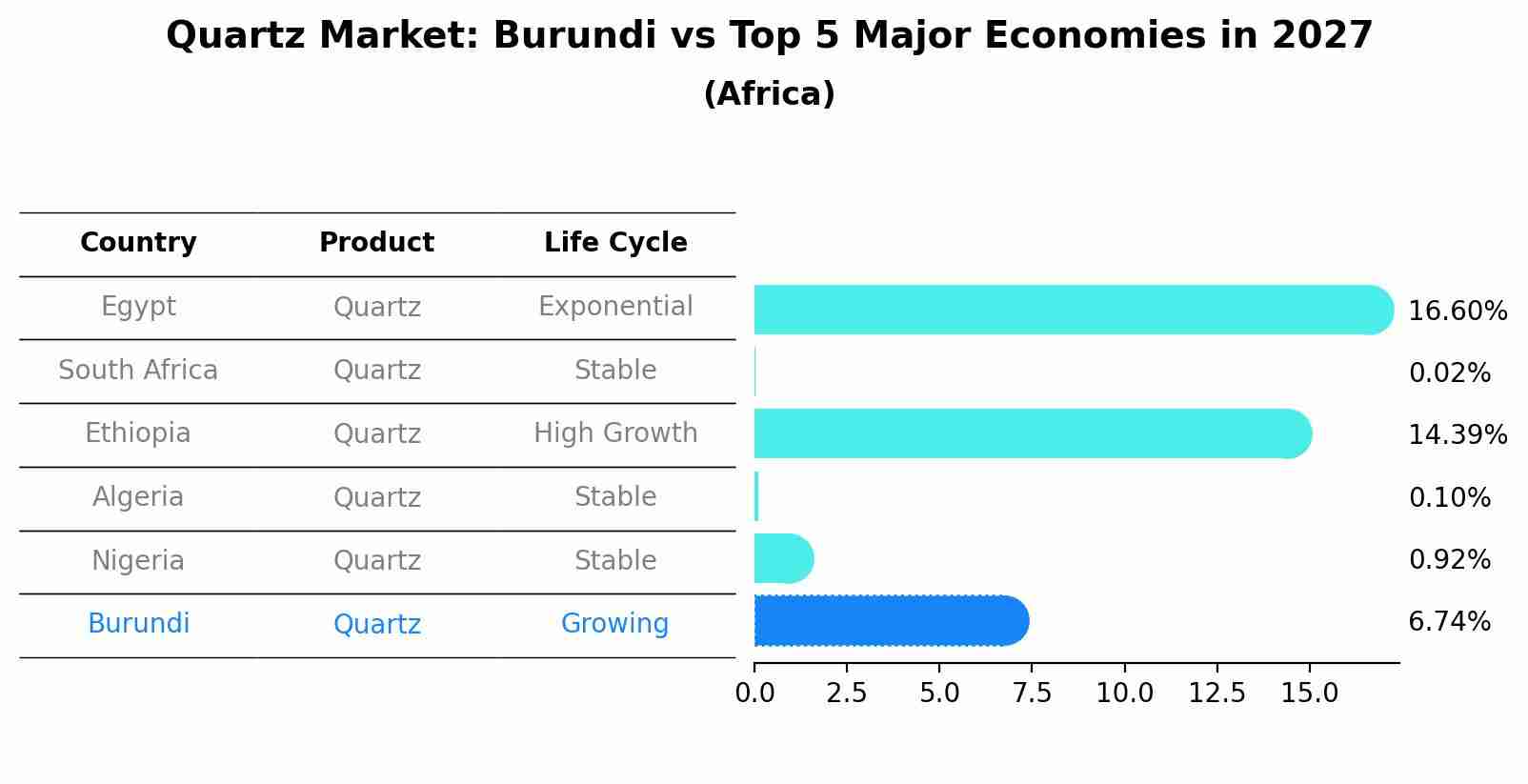Burundi Quartz Market (2025-2031) | Share, Analysis, Industry, Outlook, Forecast, Companies, Segmentation, Size, Value, Growth, Revenue & Trends
| Product Code: ETC4653018 | Publication Date: Nov 2023 | Updated Date: Apr 2025 | Product Type: Market Research Report | |
| Publisher: 6Wresearch | Author: Shubham Deep | No. of Pages: 60 | No. of Figures: 30 | No. of Tables: 5 |
Burundi Quartz Market Size Growth Rate
The Burundi Quartz Market is likely to experience consistent growth rate gains over the period 2025 to 2029. From 4.42% in 2025, the growth rate steadily ascends to 7.88% in 2029.

Quartz Market: Burundi vs Top 5 Major Economies in 2027 (Africa)
The Quartz market in Burundi is projected to grow at a growing growth rate of 6.74% by 2027, within the Africa region led by Egypt, along with other countries like South Africa, Ethiopia, Algeria and Nigeria, collectively shaping a dynamic and evolving market environment driven by innovation and increasing adoption of emerging technologies.

Burundi Quartz Market Overview
The quartz market in Burundi is small but holds potential due to the mineral`s widespread use in various industries, including electronics, construction, and jewelry. Quartz is valued for its durability, resistance to corrosion, and versatility. The market is primarily driven by the construction industry`s demand for quartz in building materials and the electronics sector`s need for quartz in the production of semiconductors and other components. However, the market faces challenges such as limited local extraction and processing facilities, leading to reliance on imports. Additionally, the lack of advanced technology for processing quartz into high-purity forms required by some industries limits the market`s growth potential.
Drivers of the market
The Burundi Quartz Market is driven by the rising demand for quartz in various applications, including electronics, construction, and jewelry. The increasing use of quartz in the production of semiconductors and photovoltaic cells is a key factor driving market growth. Moreover, the construction industry in Burundi is experiencing growth, leading to higher demand for quartz in the production of building materials such as countertops and flooring. The gemstone industry also contributes to the market, with quartz being a popular choice for jewelry.
Challenges of the market
The quartz market in Burundi faces challenges related to the country`s limited mining and processing capabilities. Although Burundi has quartz deposits, the extraction and processing infrastructure is underdeveloped, leading to a reliance on imports. The high cost of importing quartz and quartz products, coupled with inadequate local expertise in refining and manufacturing, further constrains market growth. Additionally, the lack of investment in the mining sector and the absence of modern technology for quartz extraction and processing are significant barriers.
Government Policy of the market
The quartz market in Burundi is influenced by government policies related to the mining sector. With the governments focus on harnessing the countrys natural resources to boost economic growth, there are policies in place that encourage the exploration and exploitation of mineral resources, including quartz. These policies include incentives for foreign investment in the mining sector, streamlined licensing processes, and initiatives aimed at value addition within the country. However, challenges such as regulatory transparency and infrastructure development need to be addressed to fully capitalize on the market potential.
Key Highlights of the Report:
- Burundi Quartz Market Outlook
- Market Size of Burundi Quartz Market, 2024
- Forecast of Burundi Quartz Market, 2031
- Historical Data and Forecast of Burundi Quartz Revenues & Volume for the Period 2021-2031
- Burundi Quartz Market Trend Evolution
- Burundi Quartz Market Drivers and Challenges
- Burundi Quartz Price Trends
- Burundi Quartz Porter`s Five Forces
- Burundi Quartz Industry Life Cycle
- Historical Data and Forecast of Burundi Quartz Market Revenues & Volume By Product Type for the Period 2021-2031
- Historical Data and Forecast of Burundi Quartz Market Revenues & Volume By Quartz Surface and Tile for the Period 2021-2031
- Historical Data and Forecast of Burundi Quartz Market Revenues & Volume By High-purity Quartzfor the Period 2021-2031
- Historical Data and Forecast of Burundi Quartz Market Revenues & Volume By Quartz Glassfor the Period 2021-2031
- Historical Data and Forecast of Burundi Quartz Market Revenues & Volume By Quartz Crystalfor the Period 2021-2031
- Historical Data and Forecast of Burundi Quartz Market Revenues & Volume By Quartz Sandfor the Period 2021-2031
- Historical Data and Forecast of Burundi Quartz Market Revenues & Volume By Others for the Period 2021-2031
- Historical Data and Forecast of Burundi Quartz Market Revenues & Volume By End-users for the Period 2021-2031
- Historical Data and Forecast of Burundi Quartz Market Revenues & Volume By Electronics and Semiconductor for the Period 2021-2031
- Historical Data and Forecast of Burundi Quartz Market Revenues & Volume By Solar for the Period 2021-2031
- Historical Data and Forecast of Burundi Quartz Market Revenues & Volume By Buildings and Construction for the Period 2021-2031
- Historical Data and Forecast of Burundi Quartz Market Revenues & Volume By Medical for the Period 2021-2031
- Historical Data and Forecast of Burundi Quartz Market Revenues & Volume By Optics and Telecommunication for the Period 2021-2031
- Historical Data and Forecast of Burundi Quartz Market Revenues & Volume By Other for the Period 2021-2031
- Burundi Quartz Import Export Trade Statistics
- Market Opportunity Assessment By Product Type
- Market Opportunity Assessment By End-users
- Burundi Quartz Top Companies Market Share
- Burundi Quartz Competitive Benchmarking By Technical and Operational Parameters
- Burundi Quartz Company Profiles
- Burundi Quartz Key Strategic Recommendations
Frequently Asked Questions About the Market Study (FAQs):
1 Executive Summary |
2 Introduction |
2.1 Key Highlights of the Report |
2.2 Report Description |
2.3 Market Scope & Segmentation |
2.4 Research Methodology |
2.5 Assumptions |
3 Burundi Quartz Market Overview |
3.1 Burundi Country Macro Economic Indicators |
3.2 Burundi Quartz Market Revenues & Volume, 2021 & 2031F |
3.3 Burundi Quartz Market - Industry Life Cycle |
3.4 Burundi Quartz Market - Porter's Five Forces |
3.5 Burundi Quartz Market Revenues & Volume Share, By Product Type, 2021 & 2031F |
3.6 Burundi Quartz Market Revenues & Volume Share, By End-users, 2021 & 2031F |
4 Burundi Quartz Market Dynamics |
4.1 Impact Analysis |
4.2 Market Drivers |
4.3 Market Restraints |
5 Burundi Quartz Market Trends |
6 Burundi Quartz Market Segmentations |
6.1 Burundi Quartz Market, By Product Type |
6.1.1 Overview and Analysis |
6.1.2 Burundi Quartz Market Revenues & Volume, By Quartz Surface and Tile, 2021-2031F |
6.1.3 Burundi Quartz Market Revenues & Volume, By High-purity Quartz? , 2021-2031F |
6.1.4 Burundi Quartz Market Revenues & Volume, By Quartz Glass? , 2021-2031F |
6.1.5 Burundi Quartz Market Revenues & Volume, By Quartz Crystal? , 2021-2031F |
6.1.6 Burundi Quartz Market Revenues & Volume, By Quartz Sand? , 2021-2031F |
6.1.7 Burundi Quartz Market Revenues & Volume, By Others, 2021-2031F |
6.2 Burundi Quartz Market, By End-users |
6.2.1 Overview and Analysis |
6.2.2 Burundi Quartz Market Revenues & Volume, By Electronics and Semiconductor, 2021-2031F |
6.2.3 Burundi Quartz Market Revenues & Volume, By Solar, 2021-2031F |
6.2.4 Burundi Quartz Market Revenues & Volume, By Buildings and Construction, 2021-2031F |
6.2.5 Burundi Quartz Market Revenues & Volume, By Medical, 2021-2031F |
6.2.6 Burundi Quartz Market Revenues & Volume, By Optics and Telecommunication, 2021-2031F |
6.2.7 Burundi Quartz Market Revenues & Volume, By Other, 2021-2031F |
7 Burundi Quartz Market Import-Export Trade Statistics |
7.1 Burundi Quartz Market Export to Major Countries |
7.2 Burundi Quartz Market Imports from Major Countries |
8 Burundi Quartz Market Key Performance Indicators |
9 Burundi Quartz Market - Opportunity Assessment |
9.1 Burundi Quartz Market Opportunity Assessment, By Product Type, 2021 & 2031F |
9.2 Burundi Quartz Market Opportunity Assessment, By End-users, 2021 & 2031F |
10 Burundi Quartz Market - Competitive Landscape |
10.1 Burundi Quartz Market Revenue Share, By Companies, 2024 |
10.2 Burundi Quartz Market Competitive Benchmarking, By Operating and Technical Parameters |
11 Company Profiles |
12 Recommendations | 13 Disclaimer |
- Single User License$ 1,995
- Department License$ 2,400
- Site License$ 3,120
- Global License$ 3,795
Search
Thought Leadership and Analyst Meet
Our Clients
Related Reports
- Germany Breakfast Food Market (2026-2032) | Industry, Share, Growth, Size, Companies, Value, Analysis, Revenue, Trends, Forecast & Outlook
- Australia Briquette Market (2025-2031) | Growth, Size, Revenue, Forecast, Analysis, Trends, Value, Share, Industry & Companies
- Vietnam System Integrator Market (2025-2031) | Size, Companies, Analysis, Industry, Value, Forecast, Growth, Trends, Revenue & Share
- ASEAN and Thailand Brain Health Supplements Market (2025-2031) | Strategy, Consumer Insights, Analysis, Investment Trends, Opportunities, Growth, Size, Share, Industry, Revenue, Segments, Value, Segmentation, Supply, Forecast, Restraints, Outlook, Competition, Drivers, Trends, Demand, Pricing Analysis, Competitive, Strategic Insights, Companies, Challenges
- ASEAN Bearings Market (2025-2031) | Strategy, Consumer Insights, Analysis, Investment Trends, Opportunities, Growth, Size, Share, Industry, Revenue, Segments, Value, Segmentation, Supply, Forecast, Restraints, Outlook, Competition, Drivers, Trends, Demand, Pricing Analysis, Competitive, Strategic Insights, Companies, Challenges
- Europe Flooring Market (2025-2031) | Outlook, Share, Industry, Trends, Forecast, Companies, Revenue, Size, Analysis, Growth & Value
- Saudi Arabia Manlift Market (2025-2031) | Outlook, Size, Growth, Trends, Companies, Industry, Revenue, Value, Share, Forecast & Analysis
- Uganda Excavator, Crane, and Wheel Loaders Market (2025-2031) | Strategy, Consumer Insights, Analysis, Investment Trends, Opportunities, Growth, Size, Share, Industry, Revenue, Segments, Value, Segmentation, Supply, Forecast, Restraints, Outlook, Competition, Drivers, Trends, Demand, Pricing Analysis, Competitive, Strategic Insights, Companies, Challenges
- Rwanda Excavator, Crane, and Wheel Loaders Market (2025-2031) | Strategy, Consumer Insights, Analysis, Investment Trends, Opportunities, Growth, Size, Share, Industry, Revenue, Segments, Value, Segmentation, Supply, Forecast, Restraints, Outlook, Competition, Drivers, Trends, Demand, Pricing Analysis, Competitive, Strategic Insights, Companies, Challenges
- Kenya Excavator, Crane, and Wheel Loaders Market (2025-2031) | Strategy, Consumer Insights, Analysis, Investment Trends, Opportunities, Growth, Size, Share, Industry, Revenue, Segments, Value, Segmentation, Supply, Forecast, Restraints, Outlook, Competition, Drivers, Trends, Demand, Pricing Analysis, Competitive, Strategic Insights, Companies, Challenges
Industry Events and Analyst Meet
Whitepaper
- Middle East & Africa Commercial Security Market Click here to view more.
- Middle East & Africa Fire Safety Systems & Equipment Market Click here to view more.
- GCC Drone Market Click here to view more.
- Middle East Lighting Fixture Market Click here to view more.
- GCC Physical & Perimeter Security Market Click here to view more.
6WResearch In News
- Doha a strategic location for EV manufacturing hub: IPA Qatar
- Demand for luxury TVs surging in the GCC, says Samsung
- Empowering Growth: The Thriving Journey of Bangladesh’s Cable Industry
- Demand for luxury TVs surging in the GCC, says Samsung
- Video call with a traditional healer? Once unthinkable, it’s now common in South Africa
- Intelligent Buildings To Smooth GCC’s Path To Net Zero


















